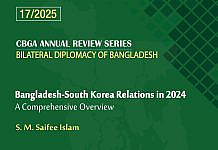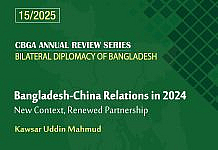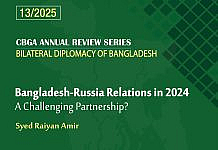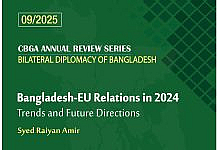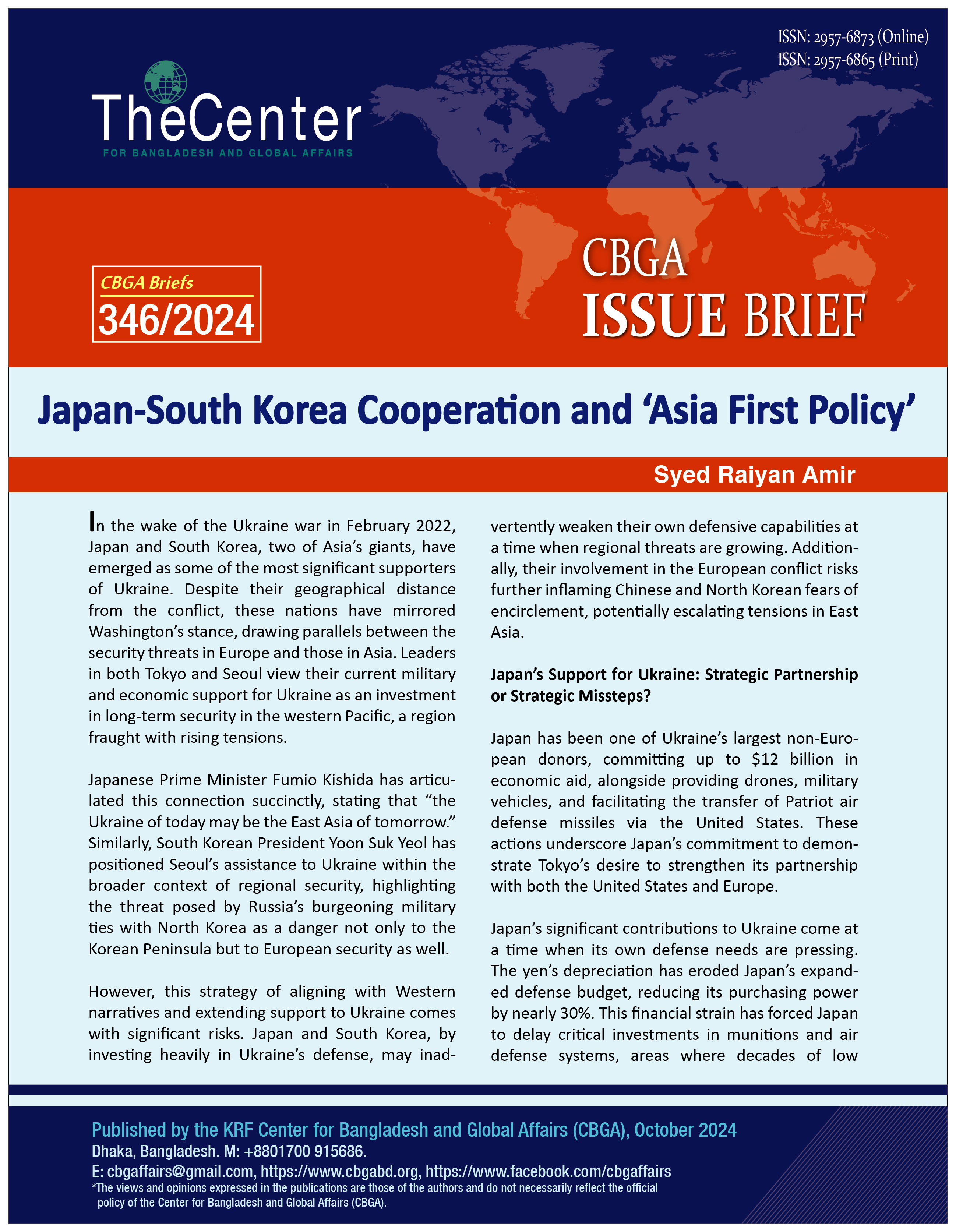
In the wake of the Ukraine war in February 2022, Japan and South Korea, two of Asia’s giants, have emerged as some of the most significant supporters of Ukraine. Despite their geographical distance from the conflict, these nations have mirrored Washington’s stance, drawing parallels between the security threats in Europe and those in Asia. Leaders in both Tokyo and Seoul view their current military and economic support for Ukraine as an investment in long-term security in the western Pacific, a region fraught with rising tensions.
Japanese Prime Minister Fumio Kishida has articulated this connection succinctly, stating that “the Ukraine of today may be the East Asia of tomorrow.” Similarly, South Korean President Yoon Suk Yeol has positioned Seoul’s assistance to Ukraine within the broader context of regional security, highlighting the threat posed by Russia’s burgeoning military ties with North Korea as a danger not only to the Korean Peninsula but to European security as well.
However, this strategy of aligning with Western narratives and extending support to Ukraine comes with significant risks. Japan and South Korea, by investing heavily in Ukraine’s defense, may inadvertently weaken their own defensive capabilities at a time when regional threats are growing. Additionally, their involvement in the European conflict risks further inflaming Chinese and North Korean fears of encirclement, potentially escalating tensions in East Asia.
Japan’s Support for Ukraine: Strategic Partnership or Strategic Missteps?
Japan has been one of Ukraine’s largest non-European donors, committing up to $12 billion in economic aid, alongside providing drones, military vehicles, and facilitating the transfer of Patriot air defense missiles via the United States. These actions underscore Japan’s commitment to demonstrate Tokyo’s desire to strengthen its partnership with both the United States and Europe.
Japan’s significant contributions to Ukraine come at a time when its own defense needs are pressing. The yen’s depreciation has eroded Japan’s expanded defense budget, reducing its purchasing power by nearly 30%. This financial strain has forced Japan to delay critical investments in munitions and air defense systems, areas where decades of low defense spending have left significant gaps. In this context, the diversion of funds and military resources to Ukraine may not be the most prudent course of action for Japan.
South Korea’s Balancing Act: Supporting Ukraine While Addressing Regional Security
South Korea, while not as deeply committed as Japan, has also made notable contributions to Ukraine’s defense. Seoul has provided non-lethal military aid, such as bulletproof vests and mine detectors, and pledged $2.3 billion for Ukraine’s long-term defense sector reconstruction. South Korea has indirectly supported Ukraine by allowing U.S.-sold military hardware to be transferred to Kyiv, including 300,000 rounds of 155mm ammunition.
South Korea’s military capabilities are more robust compared to Japan, but they are not without vulnerabilities. The country still lacks sufficient logistics capabilities and munitions stockpiles required for a prolonged conflict, and it remains reliant on U.S. combat support. Given these limitations, Seoul’s decision to donate substantial amounts of ammunition to Ukraine raises questions about the potential impact on its own defense readiness.
Should South Korea decide to extend more direct military aid to Ukraine, it will face increasingly difficult trade-offs between maintaining its defense resilience and supporting a distant conflict. The more resources Seoul diverts to Ukraine, the less it will have available to address the growing threats in its own region.
The Strategic Consequences: Risks of Escalating Regional Tensions
The growing involvement of Japan and South Korea in the European conflict has not gone unnoticed by their regional adversaries. China and North Korea, both of whom perceive a global U.S.-led security bloc aimed at containing their ambitions, have responded with increasing suspicion. Beijing, in particular, reacted strongly to the participation of Tokyo and Seoul in the recent NATO summit, which included discussions on Ukraine. China even warned Japan beforehand that such actions could damage the mutual trust between the two nations.
By aligning more closely with NATO, Japan and South Korea risk exacerbating the very insecurities they seek to mitigate. Chinese and North Korean fears of encirclement could lead to heightened regional tensions and increase the likelihood of military provocations. Rather than enhancing security in East Asia, this strategy might inadvertently make the region more volatile.
Rethinking the Approach: Prioritizing Regional Security Over Distant Conflicts
Despite the arguments made by leaders in Tokyo and Seoul, the path to preventing conflict in East Asia may not lie through Ukraine. Instead, Japan and South Korea would do well to focus on strengthening their own defenses and those of their regional partners. By investing heavily in their military capabilities, these nations can turn East Asia into a region that is difficult to conquer and, thus, less appealing to potential aggressors.
For Japan, this would involve redirecting the financial and military aid currently earmarked for Ukraine towards bolstering its own defense systems. Priorities should include enhancing naval mines, air defense capabilities, and reinforcing military infrastructure. Given the challenges posed by a weakening yen and the need for significant defense upgrades, Japan cannot afford to spread its resources too thin. South Korea, on the other hand, should concentrate on expanding its defensive arsenal and developing the combat support capabilities necessary for enduring a protracted conflict. As a major exporter of military equipment, South Korea is also in a position to strengthen the defenses of other regional players such as the Philippines, Indonesia, and Vietnam. By doing so, Seoul can contribute to a broader regional security framework that deters aggression and maintains stability.
But above all, they must act on the same pitch and if possible on a same platform. And that is on the way also.
Strengthening Asian Unity
On May 27, 2024, the leaders of South Korea, China, and Japan issued a joint declaration, signaling a renewed commitment to cooperation across various sectors, emphasizing the “Asia First” approach. This agreement came after a significant three-way summit, the first of its kind in over four years, involving South Korean President Yoon Suk Yeol, Japanese Prime Minister Fumio Kishida, and Chinese Premier Li Qiang. The declaration outlines key areas of collaboration, including regular trilateral summits and ministerial meetings to ensure tangible benefits for citizens of the three countries. Japan is set to host the next summit, further solidifying these efforts. The leaders committed to expanding people-to-people exchanges, targeting 40 million interactions by 2030, through initiatives in culture, tourism, and education. In addressing climate change, the nations pledged to work together towards achieving net-zero greenhouse gas emissions and carbon neutrality, alongside combating environmental challenges like dust storms and marine pollution.
Economic cooperation was another focal point, with a mutual agreement to accelerate discussions on a trilateral Free Trade Agreement (FTA). The countries reaffirmed their support for an open, rules-based multilateral trading system under the World Trade Organization (WTO) and committed to enhancing supply chain cooperation. The leaders adopted a joint statement on preventing future pandemics and agreed to tackle the challenges posed by low birth rates and aging populations through government and expert exchanges. On regional peace, they reaffirmed their shared responsibility to maintain stability on the Korean Peninsula and in Northeast Asia, reiterating their positions on denuclearization and related issues. This joint declaration marks a significant step towards strengthening regional ties and prioritizing Asian collaboration.
Renewing Ties: Japan and South Korea’s Strategic Defense Breakthrough
On June 1, 2024, South Korean Defense Minister Shin Won-sik and Japanese Defense Minister Kihara Minoru reached a pivotal agreement to restore bilateral defense ties, which had been essentially frozen since 2018. This significant development, occurring on the sidelines of the Shangri-La Dialogue in Singapore, marked a breakthrough in Japan-South Korea relations, despite the event’s usual focus on U.S.-China relations.
Tensions between Japan and South Korea had escalated in December 2018 following an incident involving Japan’s Maritime Self-Defense Force (MSDF) and the Republic of Korea Navy (ROKN). The issue had kept defense ties between the two nations at a standstill. However, after months of quiet negotiations, the ministers agreed to resume defense exchanges, including regular vice-ministerial dialogues and high-level engagements between the Japanese Self-Defense Forces (SDF) and the South Korean military.
This agreement signals a deepening strategic alignment between Japan and South Korea, extending beyond their shared concerns over North Korea. The joint statement issued after the meeting highlighted the mutual benefits of bilateral security cooperation and its importance in realizing a free and open Indo-Pacific. The agreement also establishes a framework to reduce the risk of future military mishaps, with improved communication protocols between naval vessels and aircraft, and adherence to the Code for Unplanned Encounters at Sea.
The timing of this agreement, shortly after the China-Japan-South Korea trilateral summit, underscores the growing momentum in Japan-South Korea-U.S. cooperation. Despite domestic challenges, the commitment of both nations’ leaders to this strategic partnership reflects a strong resolve to maintain regional stability and uphold a rules-based order.
Conclusion: A Shift Towards an ‘Asia First’ Policy
Japan and South Korea’s willingness to support Ukraine demonstrates their commitment to certain international actors. However, with the security landscape in East Asia becoming increasingly complex, these nations must carefully weigh the costs and benefits of their involvement in distant conflicts. A shift towards an ‘Asia First’ policy, where Tokyo and Seoul prioritize regional security over global commitments, may be the most prudent strategy moving forward. By focusing on strengthening their own defenses and those of their neighbors, Japan and South Korea can better safeguard their interests and contribute to a stable and secure East Asia. In an era of geopolitical uncertainty, the decision to prioritize regional stability over distant alliances could prove crucial in preventing conflict and maintaining peace in one of the world’s most strategically important regions.
– Syed Raiyan Amir is a Senior Research Associate at the KRF Center for Bangladesh and Global Affairs (CBGA).



